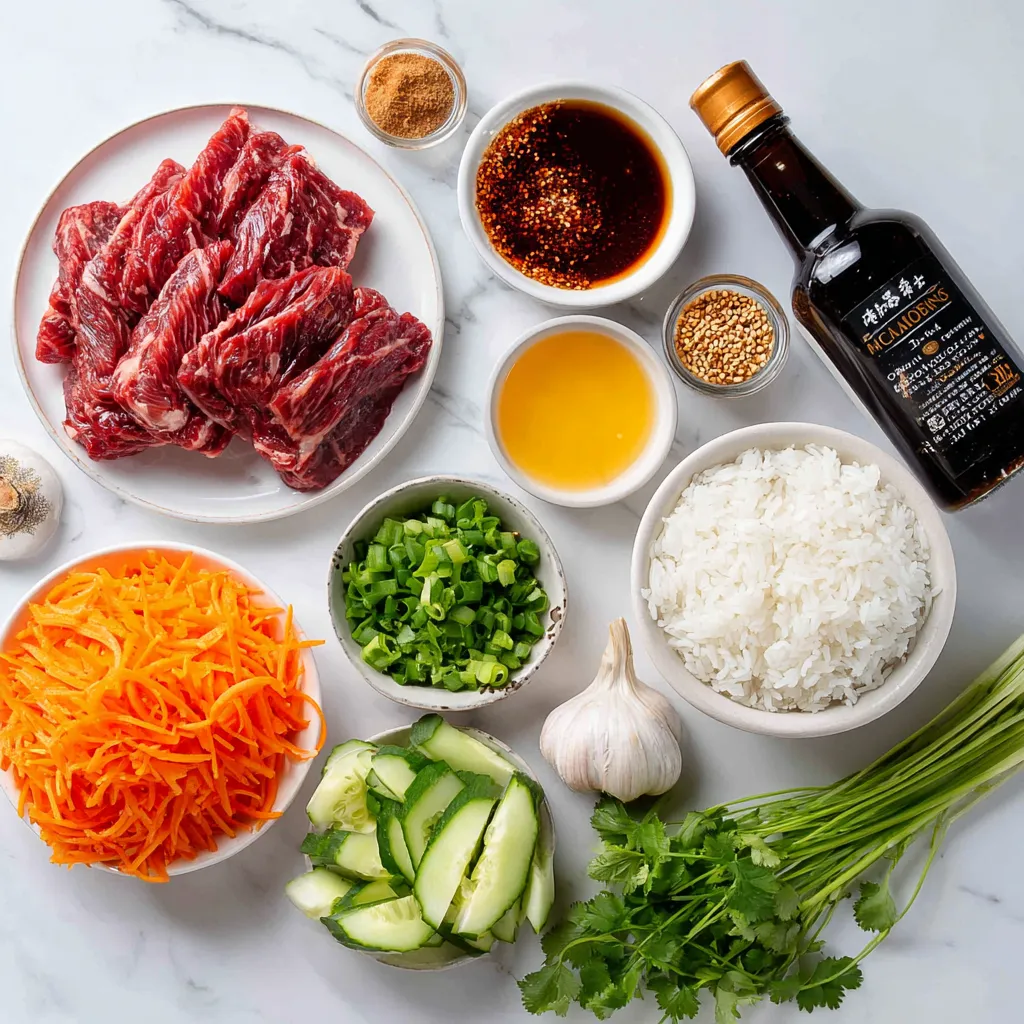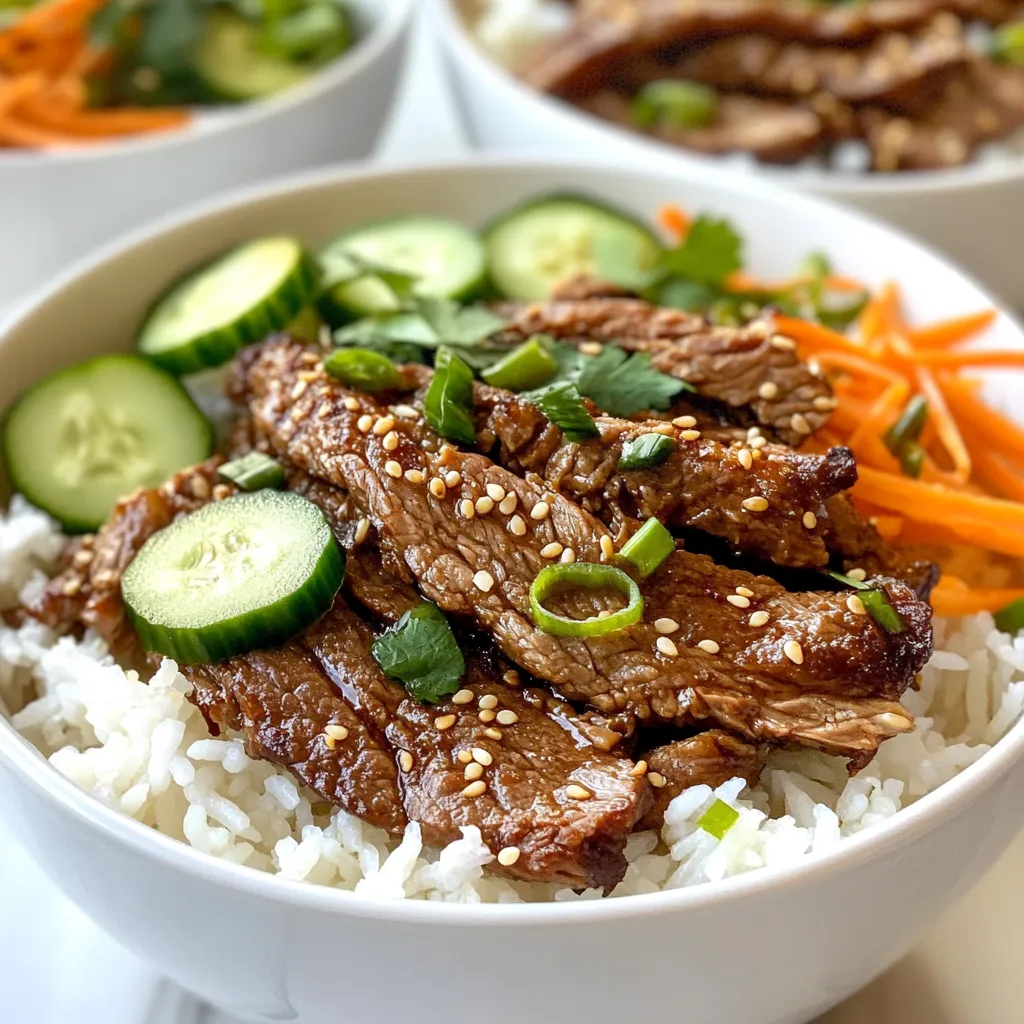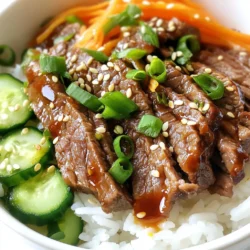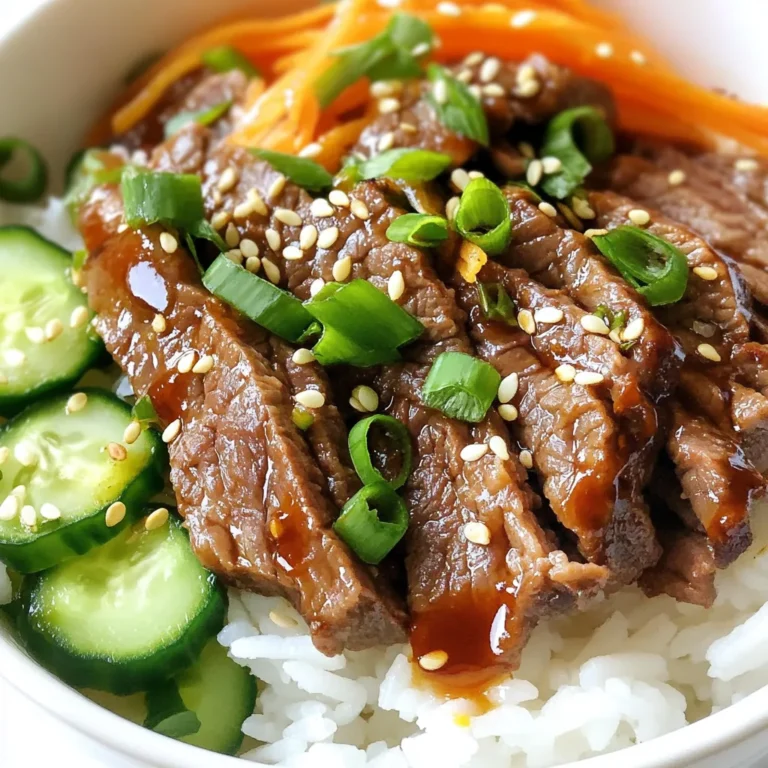Craving a meal that’s full of flavor and easy to make? Let’s dive into Spicy Korean Beef Bulgogi Bowls! This dish combines tender beef soaked in a rich soy marinade with fresh veggies. Whether you’re cooking for your family or hosting friends, this recipe is sure to impress. In this guide, I’ll walk you through every step to create a delicious bowl filled with spice and crunch. Let’s get started!
Why I Love This Recipe
- Bold Flavor Profile: This dish packs a punch with its unique blend of spicy gochujang and sweet brown sugar, creating a delightful balance that tantalizes the taste buds.
- Quick and Easy: With a total prep and cooking time of just 40 minutes, this recipe is perfect for busy weeknights when you want something delicious without spending hours in the kitchen.
- Customizable Ingredients: Feel free to add your favorite veggies or adjust the spice level to suit your taste, making this dish versatile for any palate.
- Beautiful Presentation: The vibrant colors of the fresh veggies and garnishes not only make the dish visually appealing but also enhance the overall dining experience.
Ingredients
Main Ingredients
- 1 lb (450g) thinly sliced beef ribeye or sirloin
- 3 tablespoons soy sauce
- 2 tablespoons brown sugar
- 1 tablespoon sesame oil
- 1 tablespoon gochujang (Korean red chili paste)
- 2 cloves garlic, minced
- 1 teaspoon ginger, grated
- 1 tablespoon vegetable oil
- 2 cups cooked jasmine rice
- 1 cup shredded carrots
- 1 cup sliced cucumber
- 1 green onion, thinly sliced
- Sesame seeds, for garnish
- Fresh cilantro, for garnish
When making Spicy Korean Beef Bulgogi Bowls, you need the right ingredients. The beef is key. I suggest using ribeye or sirloin. These cuts are tender and flavorful.
Next, focus on the marinade. You will mix soy sauce, brown sugar, sesame oil, gochujang, minced garlic, and grated ginger. The marinade adds flavor and depth to the beef. It’s best to let the beef soak in this mix for at least 30 minutes.
Don’t forget the toppings! Shredded carrots and sliced cucumber add crunch. Green onions, sesame seeds, and cilantro bring color and freshness. Each part contributes to a tasty bowl.
These ingredients come together to create a meal that is both simple and flavorful. You can find all these items at your local grocery store. Get ready to enjoy a delicious meal with your family!

Step-by-Step Instructions
Marinating the Beef
Marinating is key to making great bulgogi. This step allows the beef to soak up all the flavors. I always let it marinate for at least 30 minutes. If you have more time, marinate it for up to 2 hours in the fridge. This longer time helps develop richer flavors. Make sure to coat the beef well with the marinade. You want every piece to taste amazing!
Cooking the Beef
Heat the pan over medium-high heat. Add vegetable oil after the pan is hot. Then, add the marinated beef in a single layer. Cook it for 3-4 minutes. Stir often to prevent burning. You want the beef to be nicely browned and cooked through. This quick cooking keeps the beef tender and juicy.
Assembling the Bowls
Now comes the fun part! Start with cooked jasmine rice in each bowl. This rice will soak up all the tasty juices. Next, add the cooked bulgogi beef on top. Then, sprinkle shredded carrots and sliced cucumber for crunch. For the final touch, garnish with sliced green onions, sesame seeds, and fresh cilantro. This makes your bowls look colorful and appetizing!
Tips & Tricks
Perfecting Flavor
To make your bulgogi just right, focus on the gochujang. This spicy paste adds heat and depth. You can adjust the spice to suit your taste. Start with one tablespoon, then add more if you want it spicier.
For marination, aim for at least 30 minutes. This helps the beef soak up all those flavors. If you have time, marinate it for two hours in the fridge. This gives the beef a stronger taste.
Cooking Techniques
To get tender beef, slice it thinly against the grain. This keeps the fibers short, making it easier to chew. Cook the beef quickly over high heat. This helps lock in moisture.
When cooking, spread the beef in a single layer. This ensures even cooking. Stir it often for about 3-4 minutes until it browns nicely. Don’t overcrowd the pan. If you have a lot of beef, cook in batches.
Serving Suggestions
For side dishes, pair your bulgogi with jasmine rice. It balances the spice well. You can also serve it with kimchi or pickled vegetables for a crunchy contrast.
For garnishes, sprinkle with green onions, sesame seeds, and fresh cilantro. These add color and flavor. Feel free to offer extra gochujang on the side for those who love heat!
Pro Tips
- Marinate Longer for Flavor: For a deeper flavor, marinate the beef for up to 2 hours in the refrigerator instead of just 30 minutes.
- Use a Cast Iron Skillet: Cooking the beef in a cast iron skillet will give it a nice sear and enhance the overall flavor.
- Customize Your Toppings: Feel free to add other toppings such as sliced radishes, kimchi, or avocado for extra texture and flavor.
- Serve with a Side of Pickles: Serving your bulgogi bowls with pickled vegetables can balance the spice and add a refreshing crunch.

Variations
Alternate Protein Options
You can switch the beef for other proteins. Chicken works great with the same marinade. Use thinly sliced chicken breast or thighs. Pork also makes a tasty choice. Thin pork loin or tenderloin adds a nice flavor. For a plant-based option, try tofu. Firm tofu absorbs the marinade well. Just press it to remove excess water, then slice and marinate. These swaps make the dish flexible and fun.
Rice Alternatives
If you want to change the rice, consider brown rice. It has more fiber and a nutty taste. Cauliflower rice is another option. It is low in carbs and adds a nice crunch. For a twist, you can use noodles. Rice noodles or soba noodles work well. Just cook them according to the package and add them to your bowl. These alternatives keep the meal exciting and delicious.
Additional Vegetable Options
Feel free to add more vegetables. Bell peppers, snap peas, or broccoli can bring new flavors. You can also add seasonal veggies. In summer, try fresh zucchini or corn. In fall, add roasted sweet potatoes or squash. These additions not only enhance the taste but also brighten up your bowl. Mixing vegetables keeps every bite fresh and interesting.
Storage Info
Refrigeration Guidelines
You can store spicy Korean beef bulgogi bowls in the fridge for up to three days. Make sure to keep them in an airtight container. When you’re ready to eat, reheat the beef in a pan over medium heat. This helps keep the beef juicy. You can also microwave it, but be careful not to overheat.
Freezing Instructions
To freeze bulgogi, first cool it to room temperature. Place the beef in a freezer-safe bag or container. Squeeze out the air to prevent freezer burn. You can freeze it for up to three months. To defrost, place it in the fridge overnight or use the microwave’s defrost setting. Cook the beef right after defrosting for the best taste.
Meal Prep Ideas
Prepping ingredients in advance saves time. Chop carrots and cucumbers and store them in the fridge. You can also marinate the beef a day ahead. This allows the flavors to develop more. During the week, quickly assemble the bowls with rice, beef, and veggies. This makes dinner easy and fun!
FAQs
What is bulgogi?
Bulgogi is a popular Korean dish. It means “fire meat” in Korean. The dish features thinly sliced beef marinated in a mix of soy sauce, sugar, garlic, and spices. It has a rich history, dating back to the Goguryeo era. Bulgogi is typically grilled or stir-fried, giving it a nice, smoky flavor. You often serve it with rice and vegetables, making it a great family meal.
Can I make bulgogi gluten-free?
Yes, you can easily make bulgogi gluten-free. Replace regular soy sauce with tamari or coconut aminos. Use gluten-free brown sugar if needed. Gochujang can also contain gluten, so choose a gluten-free brand. These simple swaps will keep the dish tasty without gluten.
What can I serve with Spicy Korean Beef Bulgogi Bowls?
You can pair bulgogi bowls with many side dishes. Here are some great options:
- Kimchi for a spicy kick
- Pickled vegetables for crunch
- Steamed broccoli for color
- A simple salad for freshness
- Egg rolls for extra flavor
These sides will enhance your meal and create a well-rounded dining experience.
How long can I marinate the beef?
For the best flavor, marinate the beef for at least 30 minutes. If you have more time, marinate for up to 2 hours in the fridge. This longer marination allows the flavors to soak in, making the beef tender and tasty. Avoid marinating for more than 24 hours, as it can change the texture.
Bulgogi bowls combine rich flavors and fresh ingredients for a delicious meal. We explored key components like marinated beef, tasty toppings, and cooking tips. Remember to choose your proteins and rice wisely for variety. Store leftovers properly to enjoy later. This dish can easily fit into any weeknight dinner plan. I hope you feel inspired to create your own bulgogi bowls and share them with others. Experience the joy of cooking and the delight of sharing good food. Enjo

Spicy Korean Beef Bulgogi Bowls
Ingredients
- 1 lb thinly sliced beef ribeye or sirloin
- 3 tablespoons soy sauce
- 2 tablespoons brown sugar
- 1 tablespoon sesame oil
- 1 tablespoon gochujang (Korean red chili paste)
- 2 cloves garlic, minced
- 1 teaspoon ginger, grated
- 1 tablespoon vegetable oil
- 2 cups cooked jasmine rice
- 1 cup shredded carrots
- 1 cup sliced cucumber
- 1 green onion thinly sliced
- to taste sesame seeds, for garnish
- to taste fresh cilantro, for garnish
Instructions
- In a medium bowl, combine the soy sauce, brown sugar, sesame oil, gochujang, minced garlic, and grated ginger. Add the thinly sliced beef and toss to coat. Let it marinate for at least 30 minutes at room temperature (or up to 2 hours in the refrigerator) for more flavor.
- Heat the vegetable oil in a large pan over medium-high heat. Once hot, add the marinated beef in a single layer and cook for 3-4 minutes, stirring frequently until the beef is well browned and cooked through.
- Divide the cooked jasmine rice among four bowls. Top each bowl with the cooked bulgogi beef, shredded carrots, and sliced cucumber.
- Sprinkle the bowls with sliced green onions, sesame seeds, and fresh cilantro for an added burst of flavor and color.
- Enjoy your spicy Korean beef bulgogi bowls hot, and feel free to add extra gochujang on the side for those who like it spicier!


